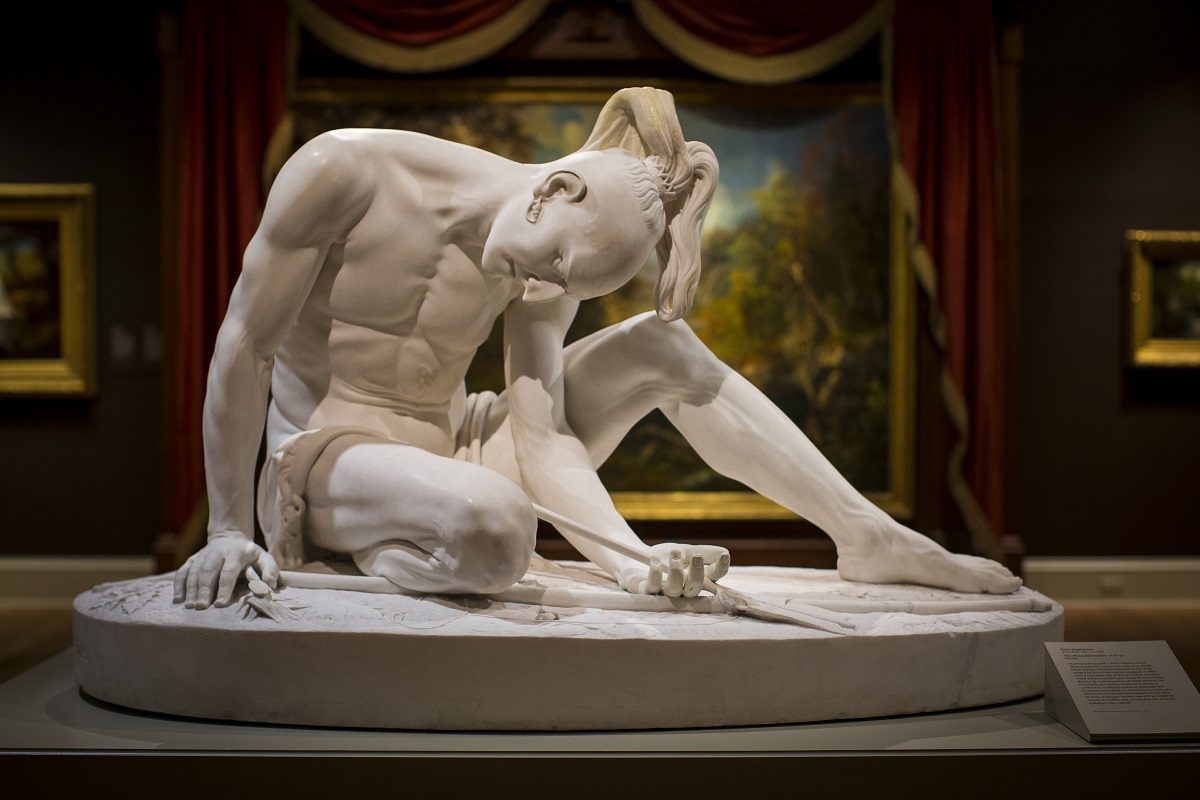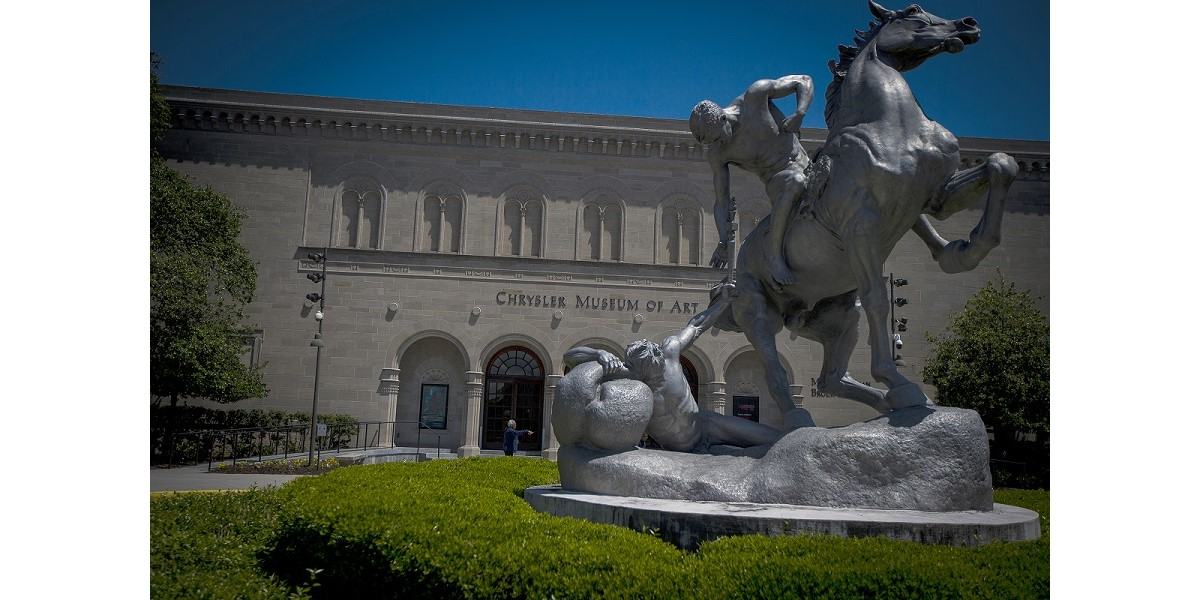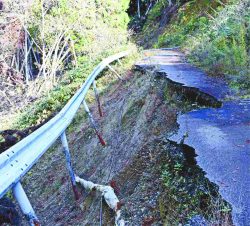
“The Wounded Indian” sculpture.
11:59 JST, May 22, 2023
NORFOLK – A visitor flipping through the records of an old New England social group in 1999 made a startling claim.
The Massachusetts Charitable Mechanic Association, founded in 1795 by Paul Revere as a kind of Rotary club for tradesmen, once owned a grand hall in downtown Boston filled with works of art and artifacts from Founding Fathers. The hall is long gone; what’s left of the collection is on loan to museums around the country or in storage.
Looking at photographs of the MCMA’s treasures in a binder, the visitor said he recognized a white marble statue depicting a wounded Native American warrior. He’d just seen it at the Chrysler Museum of Art in Norfolk.
Not possible, the association’s executive director responded. That one was destroyed during a move in the 1950s. But the visitor was adamant.
So the director traveled to the Chrysler to see for himself. And there it was: “The Wounded Indian,” a magnificent sculpture by Peter Stephenson, created in 1850 and displayed for decades at Mechanics Hall in Boston until its reputed destruction.
How did it wind up in Norfolk? Answering that question took years of detective work and left a mystery at its core. Each institution interprets that mystery differently, and so the two are at loggerheads – both claiming ownership of one of the Chrysler’s signature works of art.
The dispute comes at a time when museums are increasingly wrestling with questions about legitimacy of ownership and attempting to correct the wrongs of the past. Last October, the Smithsonian Institution joined other organizations around the world in returning Benin bronzes to Nigeria, where they had been looted by the British army more than a century ago. The Chrysler itself is in the process of returning two Nigerian pieces.
The case of “The Wounded Indian,” which hinges on events more than 60 years ago that no living person is known to have witnessed, has not been so readily resolved. It involves two freewheeling characters from the art world of the 1960s and 1970s and pits one nonprofit community organization against another.
The dispute “sounds like a question on a law school final exam, given the complicated and different issues which are coming into play here,” said Thomas Danziger, a New York lawyer with a specialty in art provenance who is not involved in this case.
Each side, though, sees it very clearly.

Erik H. Neil, director of the Chrysler Museum of Art, discusses the sculpture on May 5.
“I feel strongly that we have the ethical and legal right to this piece,” Chrysler museum director Erik Neil said in an interview with The Washington Post.
“We just reached the point where we said, this is crazy. We want the damn thing back,” said Chuck Sulkala, president of the MCMA board. “It’s that simple.”
“The Wounded Indian” wasn’t always something people would fight over.
Its sculptor, Stephenson, was a little-known Boston artist when he debuted his ambitious masterpiece in England in 1851. The sculpture drew immediate attention as the first major work carved entirely from American marble – quarried in Vermont – and for its stunning beauty.
The portrait of a dying warrior who has just pulled an arrow out of his chest was based on a famous sculpture from antiquity called “The Dying Gaul.” Stephenson won praise for his attention to detail – the fine veins in the warrior’s arms and legs, the folds of his stomach, the overall appearance that led one reviewer to say he could tell the subject was a woodlands Indian, not from the plains.
And the subject was timely, speaking to a new awareness that the nation’s Indigenous cultures were disappearing as Europeans pushed westward.
But Stephenson struggled to find a market for his creation after it returned to Boston. He developed a reputation for carving portrait busts of the city’s elite, but never surpassed “The Wounded Indian” and died in 1861, at the age of 37, in a mental facility.
After that, the fate of the sculpture grows murky. The Chrysler obtained it in 1986 when the museum’s benefactor – Walter P. Chrysler Jr., son of the automaker – acquired a batch of marble statues from a collector named James H. Ricau.
The museum had little idea where the statue had been for more than a century. In “A Marble Quarry,” a book about Ricau’s collection of sculptures published by the Chrysler in 1997, the ownership history of “The Wounded Indian” has only two entries: A Boston charitable institution called the Mercantile Library Association had acquired it “by 1856.” And Ricau owned it “by 1967.”
When the MCMA showed up in 1999 raising questions, the museum suggested that the association’s statue had been a copy. Its members were not well-equipped to figure out if that was true.
For one thing, many of the MCMA’s documents were destroyed in a warehouse fire in 1973. And the group no longer had any experience in fine arts.
The association was founded at a time when art was considered a skilled trade, with members that included architects, publishers and shipbuilders. During the 1800s, the group amassed a collection of works that included paintings by the artist Jane Stuart and scientific equipment that belonged to Benjamin Franklin.
Today’s members, with headquarters in a small building in Quincy, Mass., are generally involved in businesses such as metal fabrication and auto repair.
The association initially had no plans to reclaim the statue, said Paul Revere III, a Boston-area attorney and fourth-great grandson of the group’s founder. It has nowhere to permanently display it, no way to protect it.
“We originally came to the Chrysler and said, ‘Look, you can have it, we’d just like to try to get it back here for six months . . . to share it with the people of Boston,'” Revere said.
But apart from a few letters between the museum and the MCMA, the issue went dormant for many years, the major questions unanswered. In 2016, when someone mentioned “The Wounded Indian” at an association board meeting, member Peter Lemonias decided to try solving what had become institutional folklore.
“I’m not an art historian,” said Lemonias, who is retiring from his metal finishing business. “But I’ve kind of immersed myself in this world.”
He hired a graduate student one summer for help with research and leaned on a friend who worked in the library at the Boston Globe. After a few years, the board retained a law firm, Cultural Heritage Partners, which specializes in art ownership cases. Slowly the story began to emerge.
A trail of letters, contemporary news reports and photographs showed that the statue had passed from Boston’s Mercantile Library, which was not affiliated with the MCMA, to a wealthy collector named William Emerson Baker in 1877. Baker displayed it in a sculpture garden until his death; his widow sold the statue and other pieces to a James W. Bartlett in 1889.
Bartlett put the statue in storage in the basement of the MCMA. In 1893, Bartlett donated the statue to the association on the condition that the members clean it and display it for the public. The MCMA installed it in a special nook in the vast exhibit hall, and there it sat until the hall was sold 65 years later, in 1958.
There’s no official record for what happened next. The association had hired workers to haul generations of artifacts out of the hall. Lemonias said that in the hubbub of the move – some items going into storage, others to various institutions – “The Wounded Indian” disappeared.
“Word went back to the board that ‘The Wounded Indian’ was damaged beyond repair and was disposed of in this chaos,” Lemonias said. All that remained was a photo, the story of the lost treasure passed down from member to member. And that, he said, was all anyone at the MCMA knew until the visitor who had seen it stopped by 40 years later.
Meanwhile, in Norfolk, the statue arrived in 1986 in the last major batch of acquisitions by the museum’s benefactor, Walter Chrysler. Its curators established only that Ricau must have owned it by 1967 because that year the Baltimore Museum of Art had written him to request it for an exhibit.
Ricau, who died in 1993, was an eccentric character who filled an old house on the Hudson River with American marble statues that, for a time in the 1960s and 1970s, had little value in the marketplace. He socialized with high-end art mavens as well as characters on the fringe; infamous art forger Ken Perenyi has claimed in his memoir and in published interviews that Ricau was an early supporter of his efforts to scam collectors.
Ricau snapped up items based on what he liked and could afford, and “he had little concern for documentation, for either posterity or profit,” former Chrysler curator H. Nichols B. Clark wrote in the museum’s book about the statues.
Chrysler himself was an idiosyncratic collector who didn’t often bother with substantiating his finds.
“We don’t have full provenance on everything from Walter’s collection,” Neil, the museum director, said. “They just – they were buying and trading, and some things we do [have documentation for] and some things we don’t. Believe me, I wish we had more documentation.”
In the art world, provenance – or ownership history – is key in establishing the value and significance of a piece. But there’s also a legal reason for it: “Museums need to know that they truly own an artwork,” the J. Paul Getty Museum in Los Angeles – which has faced high-profile ownership questions – says in an article on its website.
Clark, the former Chrysler curator of American art, wrote to several Boston institutions in 1991 trying to close the gaps in the “The Wounded Indian’s” history, according to documents obtained by the MCMA’s law firm.
To the Massachusetts Horticultural Society, Clark wrote that Ricau “is somewhat vague about where he got it.” While the collector said he purchased the statue from a Boston gallery, Clark wrote, “they have no record of such a transaction which is very unusual for them.”
In recent years, as the back-and-forth with the MCMA has played out, the museum has updated its provenance for the piece. It no longer questions whether there might have been a copy and lists the mechanics association as the owner before Ricau.
Neil, who has been the museum’s executive director for nine years, said he sympathizes with the association but thinks the central issue is obvious.
“The institution disposed of it as damaged in the fifties,” he said.
Now, Neil said, the members regret that decision. “I get that. But it doesn’t it mean that it was illegal or unjustified or anything nefarious,” he said. “They’re not a museum. They were moving. It’s a big, hulking piece of marble. You could absolutely understand why.”
He added that Ricau had not stashed the statue in a shed somewhere – it had been on loan to a museum in Newark, where it was displayed for some 10 years before Chrysler acquired it.
The Chrysler’s records indicate that the piece arrived missing all the fingers from the figure’s left hand as well as part of the hair and an arrow shaft. Those features have been replaced, and the statue thoroughly cleaned.
Thaddeus Stauber, a lawyer in Los Angeles with the firm Nixon Peabody who has long experience in art ownership cases but no involvement in this one, said he is not surprised by the lack of a document trail.
Buying a car or house might generate titles and deeds, Stauber said, but “art has never been that way, there’s not a central required registry.”
Based on a description of the Chrysler case, Stauber said it’s not necessarily a matter of who’s right or wrong. “Nobody is a bad person in this, nobody is ill-intended. They’re trying to get to the merits of it but likely can’t because of the passage of time and loss or lack of documentation,” he said.
The two sides came close to resolving their differences in late 2020. Lawyers for the association wanted the MCMA’s ownership recognized; they wanted the statue to make a temporary appearance in Boston; and they wanted $200,000 to cover legal and research expenses.
A deputy city attorney for the city of Norfolk, which provides some of the museum’s $10 million annual operating budget, replied three months later. Yes on the credit; maybe on the loan of the artwork; no way on the payment, calling it a “frankly outrageous monetary demand.”
Last year, when the association finally got access to all the documentation held by the museum – such as the 1991 letters outlining the effort to pin down Ricau’s ownership – its lawyers accused the museum of bad faith. Among other details, the documents showed that the Chrysler continued to question whether the MCMA’s statue was a copy long after museum officials knew that wasn’t the case, said Greg Werkheiser, a Richmond-based lawyer representing the association.
“We said this dishonesty is unacceptable and we’re no longer negotiating for the statue to stay there,” Werkheiser said.
A spokeswoman for the museum rejected the accusation, adding that director Neil “can’t speak to what was done before he arrived.” For a time, there was “legitimate doubt” about whether the association had owned a copy, spokeswoman Ashley Grove Mars said via email.
After more research, the museum “made the determination that we are probably dealing with just one marble sculpture,” Mars said. But the group “has never produced a credible explanation of how they disposed of the sculpture in the 1950s.”
Lemonias said the MCMA recently reported the case to the FBI, reasoning that whatever happened to the statue in 1958 amounted to theft. A spokeswoman for the FBI’s Boston field office declined to comment on the situation. The museum said it has not been contacted by anyone in law enforcement.
Sulkala, the association’s president, said he feels frustrated that what started as a simple effort at recognition has reached such an impasse. But the longtime auto body repair shop owner visited the Chrysler a couple of years ago and came away impressed.
“I will say this – they’ve done a remarkable job in showing it,” he said. “The Wounded Indian” sits in the center of a dark-walled room, surrounded by huge paintings of the early American wilderness. The marble figure, roughly life-size, is visible from at least four galleries away, framed by doorways and highlighted under dramatic lighting.
“To see it – I won’t say I was tearful, but it leaves such an impression,” Sulkala said. “It is just magnificent. Honestly, I’m not one who visits art museums, but I tell you what. This was a special piece of sculpture.”

The Chrysler Museum of Art in Norfolk, where “The Wounded Indian” sculpture is housed.
"News Services" POPULAR ARTICLE
-

American Playwright Jeremy O. Harris Arrested in Japan on Alleged Drug Smuggling
-

Japan’s Nikkei Stock Average as JGB Yields, Yen Rise on Rate-Hike Bets
-

Japan’s Nikkei Stock Average Licks Wounds after Selloff Sparked by BOJ Hike Bets (UPDATE 1)
-

Japan’s Nikkei Stock Average Buoyed by Stable Yen; SoftBank’s Slide Caps Gains (UPDATE 1)
-

Japanese Bond Yields Zoom, Stocks Slide as Rate Hike Looms
JN ACCESS RANKING
-

Tokyo Economic Security Forum to Hold Inaugural Meeting Amid Tense Global Environment
-

Keidanren Chairman Yoshinobu Tsutsui Visits Kashiwazaki-Kariwa Nuclear Power Plant; Inspects New Emergency Safety System
-

Imports of Rare Earths from China Facing Delays, May Be Caused by Deterioration of Japan-China Relations
-

University of Tokyo Professor Discusses Japanese Economic Security in Interview Ahead of Forum
-

Japan Pulls out of Vietnam Nuclear Project, Complicating Hanoi’s Power Plans





















